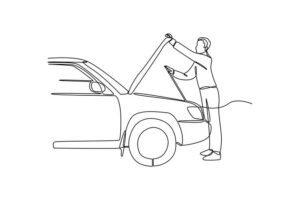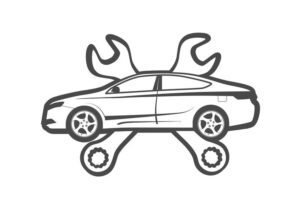Ever been driving along, minding your own business, when that little orange engine icon decides to light up your dashboard? Your heart sinks a little. You pull over, plug in your trusty OBD-II scanner, and it spits out a code you’ve never seen before: P219B. What in the world does “Bank 2 Air/Fuel Ratio Imbalance” even mean?
Don’t you worry. I’m Darman, and today we’re going to demystify this code together. Think of me as your friendly neighborhood mechanic, here to guide you through the fog. It sounds complicated, but once you break it down, it’s a puzzle you can absolutely solve.
In a Nutshell: P219B Quick Facts
- What it Means: The code P219B signifies that your car’s computer (PCM) has detected an imbalance in the air-to-fuel mixture between the cylinders on “Bank 2” of your engine.
- Common Symptoms: The check engine light is the biggest clue, but you might also notice a rough idle, worse gas mileage, or a lack of power.
- Top Causes: The most common culprits are faulty oxygen sensors, leaky fuel injectors, vacuum leaks, or fuel pressure issues.
- Is it Serious? While you can often still drive, ignoring it can lead to engine damage or a very expensive catalytic converter replacement down the road. It’s best to address it sooner rather than later.
So, What Exactly is the P219B Code?
Let’s break it down into plain English. Your engine is constantly trying to achieve the perfect recipe for combustion: about 14.7 parts air to 1 part fuel. This is called the stoichiometric ratio.
Now, imagine your engine is a V6 or V8. It has two sets of cylinders, or “banks.”
- Bank 1 is the side of the engine that has cylinder #1.
- Bank 2 is the opposite side.
The P219B code means the computer has noticed that on Bank 2, the air/fuel recipe isn’t consistent across all the cylinders. One cylinder might be getting too much fuel (running “rich”) while another is getting too little (running “lean”). It’s like a chef trying to bake two cakes at once, but one is getting way more sugar than the other. The engine’s main chef, the Powertrain Control Module (PCM), senses this imbalance and throws up the P219B flag to get your attention.

Common Symptoms of a P219B Code
Your car has ways of telling you something’s wrong besides just the check engine light. If you have a P219B code, you might also experience:
- Rough Idle: The engine might shake or stutter when you’re stopped at a light.
- Poor Fuel Economy: You’ll find yourself visiting the gas station more often. This is one of the most common complaints.
- Lack of Power: The car may feel sluggish or hesitate when you accelerate.
- Engine Misfiring: You might feel a noticeable “miss” or stumble as the engine struggles to run smoothly.
- Strange Smells: In some cases, you might notice a rotten egg smell from the exhaust, which is a sign of unburnt fuel hitting the hot catalytic converter.
What Causes the P219B Air/Fuel Imbalance? (The Usual Suspects)
Okay, we know what it is and what it feels like. Now for the most important part: why is it happening? Here are the most common culprits, starting with the simplest.
Faulty Oxygen (O2) or Air/Fuel Ratio Sensors
These sensors are the “noses” of your engine. They sit in the exhaust and “sniff” the fumes to tell the computer how the air/fuel mixture is doing. If the Bank 2 sensor is old, contaminated, or just plain broken, it can send bad data. The computer then tries to “fix” a problem that doesn’t exist, creating the imbalance.
Leaking or Clogged Fuel Injectors
Think of a fuel injector as a tiny, precise spray nozzle. If one on Bank 2 gets clogged with debris, it won’t deliver enough fuel to its cylinder (a lean condition). Conversely, if an injector’s seal fails and it’s leaking, it will deliver too much fuel (a rich condition). Either scenario throws off the balance for that entire bank.
Pesky Vacuum Leaks
This is a big one. The engine’s computer meticulously measures all the air coming in through the intake. A vacuum leak is like a secret back door—a cracked hose or a bad gasket lets unmetered air sneak into the engine. This extra air leans out the mixture in one or more cylinders on Bank 2, causing the computer to compensate by adding more fuel, which throws everything out of whack.
Fuel Pressure Problems
If the fuel pump is weak or the fuel pressure regulator is failing, the entire engine can be starved for fuel. While this often affects both banks, sometimes it can present as an issue on just one, leading to a P219B code.
How to Diagnose and Fix the P219B Code: A Step-by-Step Guide
Ready to put on your detective hat? Let’s walk through the diagnostic process logically. The key is not to just throw parts at the problem!
Step 1: Read the Freeze Frame Data
Before you clear the code, use your OBD-II scanner to look at the “freeze frame” data. This is a snapshot of what the engine was doing the exact moment the code was triggered. Look at things like engine temperature, RPM, and fuel trim data. This can give you valuable clues.
Step 2: Check Your Fuel Trims
This is where a good scanner comes in handy. Look at the Short-Term (STFT) and Long-Term Fuel Trim (LTFT) for Bank 2.
- High positive numbers (e.g., +15% or more): The computer is adding a lot of fuel. This points toward a lean condition, like a vacuum leak or a clogged injector.
- High negative numbers (e.g., -15% or more): The computer is removing fuel. This suggests a rich condition, like a leaking fuel injector.
Step 3: Perform a Thorough Visual Inspection
Pop the hood and look around the Bank 2 side of the engine. Check all vacuum lines for cracks, breaks, or loose connections. Look for any signs of exhaust leaks (black soot) near the exhaust manifold before the O2 sensor. Check the wiring for the O2 sensors and fuel injectors for any damage.
Step 4: Smoke Test for Vacuum Leaks
If you suspect a vacuum leak but can’t see it, a smoke test is the gold standard. A machine pumps harmless smoke into the intake manifold. Wherever you see smoke coming out, that’s your leak!
Step 5: Test the Fuel System
If you suspect a fuel delivery issue, test the fuel pressure using a fuel pressure gauge. The reading should be within the manufacturer’s specified range. If you suspect an injector, you can perform an injector balance test or, for a simpler check, use a mechanic’s stethoscope to listen to each injector on Bank 2. They should all have a consistent, crisp clicking sound.
You’ve Got This!
A P219B code might seem daunting, but it’s just your car’s way of telling you something needs attention. By following a logical diagnostic path—from checking data to visual inspections to targeted tests—you can pinpoint the root cause without wasting money on parts you don’t need. Take it one step at a time, and don’t be afraid to ask for a professional opinion if you get stuck. You can get to the bottom of this and have your engine purring perfectly again.

Frequently Asked Questions (FAQ)
Can I still drive my car with a P219B code?
You can, but it’s not a good idea for an extended period. Continuing to drive can lead to very poor fuel mileage, reduced engine performance, and could eventually damage your expensive catalytic converter. It’s best to get it diagnosed and fixed promptly.
How much does it cost to fix a P219B code?
The cost can vary dramatically. A simple fix like a cracked vacuum hose might only cost a few dollars. A new oxygen sensor could be $100-$250, and a faulty fuel injector could be similar. The most cost-effective approach is a proper diagnosis first to avoid replacing parts that aren’t broken.
I have a Ford F-150 and got this code. Is it a common problem?
Yes, the P219B code is relatively common on some engines, including those in the Ford F-150 lineup. The causes are the same as listed above, with leaky fuel injectors and vacuum leaks being frequent culprits on these trucks.


